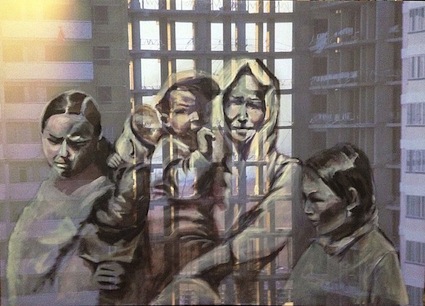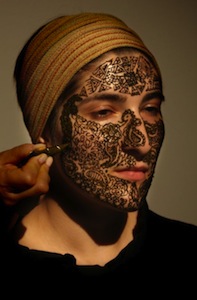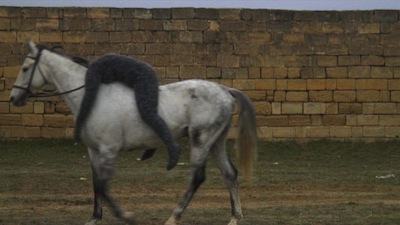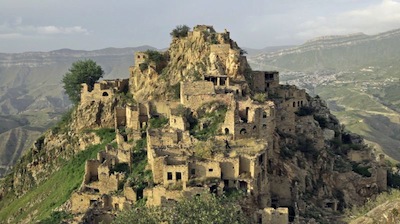If decolonial phenomenology deals with the Duboisean question of what it means to be a problem, decolonial aestheSis, linking reason and imagination through epistemology, focuses not on Caliban’s reason but on Caliban’s art, and not on decorative and ornamental art (which before was the only kind of creativity allowed for Calibans), but а full-fledged art that is quickly becoming an important part of the contemporary, socially and politically engaged art scene. When Caliban turns from an object, a decoration highlighting the sublime of nature, into a subject with his own agency and aestheSis, the usual connection between the beautiful, the sublime, and the particular phenomena, actions, and events signifying them, takes a different meaning–an object acquires a voice, and an ability to suffer, to experience humiliation, and eventually to build an alternative world out of this misery and tenacity, and to react to this experience through aesthetic means. Decolonial art focuses on demonstrating the underside of the Western beautiful and sublime and gives subjectivity and creativity back to Calibans.
The Observatory of the Bereaved: Unbinding the Imaginary in Eurasian Borderlands
In locales where the resources are scarce and the imperial-colonial configurations more complicated than in the West-East or North-South dichotomies, the politics of physical survival and the politics of servility towards the criminal state unfortunately dominate. There are no recipes against this, other than delinking and disobeying. And most of decolonial artists in this situation and in such spaces are confined to the position of subversive tricksters and negotiators, creating, little by little, a decolonial transmodern “community of sense,” to paraphrase J. Ranciere, 2009.
This is the case with the art practices of Eurasian borderlands and particularly such post-Soviet-colonial locales as the Caucasus and Central Asia. They are marked by multiple forms of coloniality, a wider spectrum of Western, not-quite-Western and non-Western native influences, and a restless shift from the position of the forced Second World to the Global South today. This leads to a specific nonbelonging of Eurasian artists — their initially wider interpretative horizon and their trickster flexibility, which does not save them from appropriation by the market or the state, neo-orientalizing in the West and in Russia–and a confinement to intuitive decolonial moves that are only starting to be theorized in public art discourse.
Such is the Buryatian artist Zorikto Dorzhiev whose Jioconda Hatun (Khankalayev 2012) subverts Western aesthetic principles. A Caliban (Zorikto), painting an ironic Miranda’s portrait, making her look like his mother Sycorax, cannot be accepted in Prospero’s reference system without being conveniently labeled a stylizing painter or an authentic (naïve) ethnic artist. One of the common mistakes in the interpretation of decolonial art is this Eurocentric progressive heresy, which sees such art as a call for going back to some essentialist pure identity fallen out of the contemporary market. In reality decolonial artists are more complex in their pluritopic hermeneutical connections than any exclusively Western or non-Western ones. Being truly border subjects they constantly play on, delink, and relink in a complex, conceptual, and at the same time spontaneous way with various Western and non-Western models from the position of exteriority–the outside created from the inside. Decolonial art is grounded in a nonexclusive duality principle which is to be found not only in multisemantic logic but also in many indigenous models. The crucial drive here is overcoming in the existential or Zen Buddhist sense, transcending in the Kantian sense, and transmodern delinking in the decolonial sense. After delinking the subject needs to relink and here resistance gives way to re-existence.
On the other hand, for post-Soviet Eurasian artists with Muslim links, the Islamic aesthetics in various (sometimes hidden or highly constructed) forms continues to play a crucial part. Since they were forced by Russian/Soviet modernity into a decidedly secular (Eurocentric) cultural and aesthetic sign system, today we mostly find creolized border forms of secular-Western/Russian (post-Soviet) and native/Muslim sensibilities, often seen through the prism of contemporary and postvanguard art which these artists were brought up on. The logic of appropriation and discrediting of other knowledges and different aestheSis allows for only certain prescribed forms for non-Russian artists, such as primitivism, a word-for-word copying of the dominant trends, or a compromise defined before in the formula “socialist in its content, national in its form” and defined today as “market or developmentalist in its essence, ersatz-official-ethnic in its form.”
In the first post-Soviet decade artists in/from the Caucasus and Central Asia strove to get rid of this formula through a contemplation of various neomythological forms that were popular in the 1970 and 1980s. P. R. Gamzatova pointed out the main leitmotivs and symbols connected with this sensibility (stone, felt, dung, Silk Road, train, hero) that helped these artists rediscover their roots in their quest for self-identification (Gamzatova 2009). In my view this “ethnic renaissance” was a preparatory stage for the decolonial sensibility of the 2000s. A decade turned out to be enough to make this groundbreaking shift, as the world itself has changed so rapidly and violently, calling the artists to turn from introspection back to social and political reality. The triumphant global coloniality quickly resulted in a new contesting decolonial aestheSis which the most sensitive artists could not ignore.
The resulting new aestheSis does not juxtapose the topicality of art and its local cosmological roots. The critique of modernity does not mean its simple rejection and return to some idealized past. Instead it is linked with the quest for projected ways into the future, which may be found in a dialogue with ethnic-cultural memory, forgotten cosmology, or even tribal continuity grounded in ecologically spiritual practices typical of all nonmodern cultures. On this level–of a reconsidered postethnic art–the first decolonial overtones started to emerge, often based on the recycling of recurrent images and motives of the 1990s but rethinking them through contemporary global, political, and social concerns, urgent in post-Soviet postcolonial puppet states.
Decolonial art in the world of imperial difference and its secondary colonial difference (mainly Central Asia and the Caucasus) is complex due to the multiple natures and contradictoriness of the colonizing agents and influences in this locale, and the Janus-faced nature of the subaltern empire (Russia) which felt itself a colony in the presence of the West and compensated by humiliating its own secondary Orient playing the caricatured role of the civilizer and modernizer. The overall coloniality of Western modernity intermingled here with Russian/Soviet modernity, marked by schizophrenic redoubling discourses and inferiority complexes. The national brands of modernity today in the newly independent states add a specific flavor to coloniality that decolonial artists incorporate critically into their works. Some Eurasian decolonial artists had a dissident political and aesthetic experience in the late Soviet epoch, which today acquires new overtones in either a forced existence in the conditions of new fundamentalism–national or religious–a diasporic mode, or an invisible border in-between double-critique sensibility capable of seeing more than in the West or in the East alone.
Kazakhstan is an interesting case of decolonial sensibility, probably the closest Eurasian version to Caliban’s protesting art, only in this case fashioned as an exaggerated “Asiatic” identity, often manifested in radical forms as the artists “exploit” their own “Kazakh” (i.e., decidedly Mongoloid) look, making themselves into emblematic Orientalist objects to articulate their aesthetic-political statements. Said Atabekov (Atabekov 2011) creatively deconstructs Genghis-Khan mythology as it is trivialized in contemporary Kazakh culture and plays on pre-Islamic, pantheist rituals and forgotten models as well as marginalized Islamic traditions (e.g., choosing a dervish identity for himself). The shocking effect of his Holy Family (2001) is produced through a combination of objects and situations from completely different times and locales, which are put together by a “traditional” Kazakh family that either does not understand the symbolic or real meaning of accidentally discovered objects–the signs of the presence of the forced global modernity in its most militaristic images–or is, maybe, knowingly reusing them in a nonaggressive, domesticated way: a woman is rocking a baby in a cradle whose handle is made of a rifle; for a canopy, a family reuses an abandoned banner of the United Nations troops.
Atabekov’s 1995 pastiche Son of the East (Atabekov 2009) is a palimpsest of semantically fluctuating contradictory images and messages: on the one hand the artist applies a recognizable ancient symbol of hearth and domestic comfort: the shanyrak, a wooden ring with an internal cross-piece used to hold together the frame of a yurt, the Kazakh traditional dwelling. Shanyrak is used in the postindependence Kazakhstan coat of arms, acting as an important symbol of the country. On the other hand, Atabekov places a figure of a naked teenaged boy wearing a traditional Kazakh felt hat inside this circle in such a way that his body is crucified (in Saint Andrew’s pose) on the shanyrak‘s cross-piece. Finally the image of the crucified human body written into the circle immediately makes a link with Leonardo da Vinci’s Vitruvian Man, with all its controversial connotations of the exclusionary ideal proportions of the human body, which set universal aesthetic standards from the Renaissance onwards. However for Atabekov this nuance is less significant than the idea of the crucifixion of the son of the East, in the entourage of officially sanctioned, frozen, ethnic-national symbols that in the end amputate his humanity.
The haunting motif of the dispensable lives of the new nomads of global coloniality reemerges again and again in Atabekov’s works. Such is his decolonial project The Observatory of the Bereaved (1998) centered around the bereaved as a specific subjectivity that the artist strives to analyze (a homeless person, a dervish, a new Noah, a nomad, an unemployed person). They obviously parallel Franz Fanon’s “wretched of the Earth.” This sensibility is to be found in other contemporary art works from Central Asia, such as Yerbossyn Meldibekov’s (Ibraeva 2007) dystopian Pastan cycle, an imagined Central Asian dictatorship where live people are sold in the market as food, packed in sacks.
Kazakh women artists marked by decolonial sensibility offer more nuanced, introspective, and less aggressive imagery. Almagul Menlibayeva is mixing various art media–from traditional felt carpet to video-art and installation–the same way she is creolizing epistemic, religious, cosmological, and cultural traditions (Sufism, Buddhism, shamanism) in her own magical trend of punk-shamanism, obvious in such works as Kissing Totems (2008). An even more complex case is Saule Suleimenova, who creates multisemantic works based on experiments with grattography, applied to modern and archival photographs mixed with painting. In her series I am Kazakh (2010), she attempts to carefully release the forgotten and suppressed impulses and sensations of the beautiful, to give people back the flavor of life and their self-respect. In doing this she acts on a different level from more detached conceptual art, interpenetrating rationality with emotions and spiritual element. She is trying to “reconnect and reconcile the traditional Kazakh culture and the aesthetics of revolt, the modernist artistic devices, the pathos of eternity and the poetics of everyday” (Suleimenova 2010). For her the main problem of contemporary Kazakhstan is an inferiority complex, a colonized consciousness grounded in a painful self-reflection, typical of young postcolonial nations. Through decolonizing visuality and, particularly, notions of the beautiful, Suleimenova attempts to teach Kazakhs to unlearn their desire for those lacquered ersatz things they were taught to like and appreciate as beautiful, and as their own. She wants to decolonize their idea of Kazakhness and free it of the bombast that is so pervasive in official state aestheTics.
Suleimenova (re)visits many versions of the past and present that are unstable, changeable, and yet retain certain recurrent and always recognizable and reconstructable elements. Such are her recent works for the international project Ultra-Memory (2012), on the verge of painting and photography, past and present, and the rational and emotional (beautiful and sublime), to produce a sensibility freed of any binding aesthetic canons and coming as much from the heart, from the childhood, from the soul, as from a conceptual analytical interpretation of an aesthetically shrewd individual. She superimposes another Kazakhness (unofficial and uncombed) onto today’s third-class (post)colonial modernity, producing a shocking and sobering decolonial effect.
Different aestheSis dominates contemporary Uzbek art. Yet the theme of dispensable lives reemerges here as well in Vyacheslav Useinov’s installation A Guest Workers Flight (Useinov 2011), which is a plane made of adobe bricks like those that are still used by peasants in Central Asia to build their houses. The unlikely combination is shocking, as is the forced modernity in this locale. What is awaiting them on the other side of the globalization-migration? The worker’s overalls closely resemble prisoners’ clothes, made of checked plastic trunks, a staple of the postsocialist shuttle-traders and refugee life. They symbolize the illegal status of millions of Uzbeks who flee their homeland to find low-paid jobs in Russia. It is an ironic way of telling an alternative history of Uzbekistan, from the adobe house through high-tech modernity, to the same age-old status of a low-paid worker with no rights, whose life has no value.
Uzbek artists ironically play on various post(neo)colonial national myths utilized by the new (old) elites, seen, for example, in the ubiquitous Tamerlan presence in contemporary Uzbekistan. Vyacheslav Akhunov (Sorokina 2006) in his counter-discursive The Doors of Tamerlan (2005) reproduces the Russian orientalist Vassily Vereshchagin’s painting. But instead of the original Tamerlan guard, the work fashions a hyper-realistically presented, modern, Uzbek uniformed guard sustaining the same power cult, and emphasizing the Uzbek administration’s forceful revival of the Timurids myth. Dispensable lives are linked with another recurrent motif of Central Asian contemporary art–that of the caravan route or, more broadly, the road as a means of survival. Here many artists play on the fundamental cultural and economic premodern pattern of this locale–the Great Silk Road–in order to stress the shifts in the interpretation of the road chronotope in the context of global coloniality. This is seen in Murat Dzhumaliyev and Gulnara Kasmaliyeva’s video installation Trans-Siberian Amazons (2004) with its close-up of Kyrgyz women shuttle-traders, the new post-Soviet nomads.
According to the tenth-century Arab geographer and historian al-Mas’udi, the Caucasus is a mountain of tongues (Shboul 1979); in our case, these are artistic languages and sensibilities that differ ethnically, religiously, linguistically, and cosmologically, yet retain some non-verbalizable pan-Caucasian community of sense. We should not lump together the post-Soviet, independent, South Caucasus states such as Azerbaijan, Georgia, and Armenia, with the remaining Russian colonies of the Northern Caucasus. Their decolonial impulses are predictably different, grounded in different local histories, imperial-colonial configurations, and independent or confederative futures. A Georgian artist Iliko Zautashvili strives to decolonize perception from stereotypes in such controversial projects as Caucasian Manifesto (2008), attempting to demystify the exoticist image of the Caucasus as well as the mythic, holistic, patriarchal, positive self-representation. Azeri artists offer their own decolonial transcultural models that question and destabilize various modernities imposed onto the Azeri liquid shifting identity, always mocking and finding its trickster ways beyond and across, such as Babi Badalov’s multilingual visual poetry mixing Latin and Cyrillic alphabets, or Orhan Guseynov’s ironic work Non-Standard (2006) in which we see a traditional Azeri cornbread Churek stuck halfway into an electric toaster where it obviously does not fit. A Daghestani, Magomed Dibirov’s SOUP (2006) falls in the same category: it depicts the artist’s niece in a way that is opposite to the standard, ear-to-ear smiling and oozing happiness, of pop-art children. With clear hatred she is looking at a big plate of Andy Warhol’s replica of the mass-produced tomato soup, which this Daghestani kid refuses to eat.
As P. R. Gamzatova points out, the Southern Caucasus and Central Asia are in a more favorable position than the Northern Caucasus because today they can shape different vectors of influence and build on dialogic connections with Europe and with the wider Muslim world, which the remaining Russian colonies are lacking (Gamzatova 2009). Yet there are decolonial impulses in the works of the Northern Caucasus artists. An interesting example is Daghestan where several dozen ethnicities, each with its own language and identity, coexist. This republic remains a part of the contemporary Russian Federation whose control is enacted in the form of familiar, post-Soviet, ethnic statism, fused with criminal groups from the center.
Magomed Dibirov (Dibirov 2012) mentioned above was born and has lived all his life in Khasavyurt, an iconic town in the contemporary history of the Caucasus and Russia, at the border of Chechnya and Dagestan. A peculiar border sensibility emerges from a straightforward metaphor in his provocative A Member of the Federation, a post-Sots-art image of Russia as a smooth brick wall, one of whose bricks–Dagestan–is defective. The idea of the deprivation of human rights, dignity, and even human rank in Dibirov’s work acquires additional salience in relation to the ubiquitous ethics of quite real war in the contemporary Caucasus. His alarming canvas Temporary Truce presents a hyperrealistic meat grinder standing head over heels on a table. Next to it lies a lonely miserable tomato, which the artist identifies with. The tomato “knows” that the truce is temporary and its time will come very soon. Dibirov could not avoid the Muslim theme, which he treats again in the ambivalent way of a border-dweller. In Security Service, for example, he contemplates the boundaries of Western tolerance and the conditions of the multicultural integration of Muslims into modern Western societies. Modernity here looms behind a beautiful ornamented arch: an entrance into the wonderful world, represented, or maybe guarded, by an unexpected materialized idiom, a gigantic safety razor. An out-of-scale, smallish figure of a traditionally dressed and bearded Muslim man stands in front of this arch not daring to enter, not sure if the razor would shave off his beard (a symbol of Muslim identity) to let him in, or if much more is to be sacrificed.
Taus Makhacheva, a diasporic artist with Russian citizenship, Western education, and Daghestani (Northern Caucasus) ethnic roots, has had her work exhibited in Russia, Europe, the postsocialist countries, and most recently at the Liverpool Biennial (2012), for which I prepared a catalogue entry. She questions the processes of integration, discrimination, and representation that have failed to provide adequate answers under the concept of Affirmative Action. It is destabilized in her skeptical work based on her own experience as an “other” in Moscow and in London (Makhacheva 2011). A playful “trying on” of alien roles does not rule out her remaining a part of the symbolic reality she is investigating, comprehending its inner logic, even if passed through a prism of the global cosmopolitan experience of a sophisticated contemporary artist.
In her video-filmed performances, the artist examines the unstable boundary between the same and the other, acceptance and rejection, drawing attention to our efforts to merge, mimic, assimilate, or leak into the other, no matter if it is another person or a community–natural or social, rural or urban, real or imagined. Makhacheva acts a participatory anthropologist-cum-artist striving to understand the contemporary social and political reality of Daghestan without exploiting or objectifying her own culture.
In her most recent video, Gamsutl (2012), she questions various masculine appropriations of space, and ways of communicating with the natural, the manmade, the animal, the machine, the human, the social, and the historical. Acquiring one’s masculinity anew through rediscovering and reliving space and going back to spatiality through gendered forms of identification, is crucial in contemporary culture. The frozen time of globalization, with its only remaining horizon of consumption and its end-of-history sensibility, makes people turn to forgotten spaces (local and global), spatial histories, and glocal identities, to various ways of possibly re-rooting in new topi–real as much as imagined and constructed.
Gamsutl is an abandoned and collapsing, hard-to-reach, ancient, human settlement carved in and from the rocks of Avarain mountain, situated along one of the offshoots of the Great Silk Road, and once famous for its skillful jewelers and armorers, as well as its religious and cultural tolerance. Its picturesque ruins are not grim, as they grow into the wild landscape, harmoniously blending with the environment, as if it is time for nature to claim its eternal rocks back from the people. The protagonist is a young man taking part in a peculiar ritual of re-membering and reenactment, and striving to carefully recreate the spatial memory of the forgotten past. Through a bodily “merging” with this space–a palimpsest of many cultural strata and dramatic historical events (the Russo-Caucasus War, Soviet modernity, the post-Soviet abandonment and return back to nature)–the “dancer” is trying to corporeally relive Gamsutl in his mimicry of natural and architectural objects. Some of his moves recreate the characters of panoramic paintings by a Russian military orientalist, Franz Roubaud (1856-1928), who was known for his series of Caucasus War canvases depicting the area surrounding Gamsutl and the soldiers of both warring parties. The dancer is trying on various identities, imagining himself alternately a defender and an assaulter, a warrior and Gamsutl’s citizen, a collective farmer and a brigade leader, incorporating Soviet modernity symbols into his traditional dance and mimicking inanimate objects–becoming a tombstone, a watchtower, a crack in the wall.
In Delinking (2011) the artist plays on this decolonial term. She was attracted to the idea of delinking from European thinking and ways of receiving knowledge, and this work emphasizes the fact that all cultures have their own different systems and practices of transmitting knowledge, of cultural and intellectual evolution, while the world uses only the sanctified Western academic system. Makhacheva’s face was intricately painted with henna using Indian, African, and Middle Eastern ornaments. As soon as her face was covered with ornaments, the spaces where skin was still visible were filled with more inscriptions until the whole visage was coated with green. After it dried and was washed off, the face changed its color to an orange-brown and stayed so for a week–a new mask, a new mocking identity–tentative, yet obviously leaving a trace. The changing face color as a space for the pluritopic overlay of different epistemic and aesthetic systems became a complex metaphor for decolonial shifting of the geography of reasoning and recreating a decolonial community of sense.
References
Atabekov, Said. 2009. Son of the East. Solo Exhibition. Laura Bulian Gallery. Milano. http://www.laurabuliangallery.com/index.html. Last accessed 09.02.2012
Atabekov, Said. 2011. Mixed Language. Lingua Franca. Central Asia Pavilion. 54th International Art Exhibition La Biennale di Venezia. http://www.cap2011.net/artistsaid2.htm. Last accessed 09.02.2012.
Dibirov, Magomed. Web-page at the Official Site of the First Gallery, Makhachkala. http://www.dagestan-art.ru/?dr=data/1306406232/1306957959&im=1309375118. Last accessed 02.08.2012.
Gamzatova, Patimat R. 2009. “Aktualniye Problemy Iskusstva v Musulmanskom Areale Stran SNG v nachale 21 veka” [Topical problems of art in the Muslim area of CIS countries in the early 21st century], pp. 56-67, in Iskusstvo Turkskogo Mira. Istoki i Evolutsija Khudozhestvennoi Kulturi Turkskikh Narodov [The art of the Turkic World. Sources and evolution of the artistic culture of the Turkic people]. A Collection of Essays, ed. P. Sultanova, Kazan.
Ibraeva, Valeria. 2007. Erbossyn Meldibekov. 2007. Nafas Art Magazine. http://universes-in-universe.org/eng/nafas/articles/2007/yerbossyn_meldibekov/photos/. Last accessed 09.02.2012
Khankhalayev Gallery. 2012. http://www.khankhalaev.com/. Last accessed 09.02.2012
Makhacheva, Taus. Affirmative Action (Mimesis). 2011. Laura Bulian Gallery. Milano. http://www.laurabuliangallery.com/index.html. Last accessed 09.02.2012.
Ranciere, Jacque. 2009. “Contemporary Art and the Politics of Aesthetics,” 31-50, in Communities of Sense. Rethinking Aesthetics and Politics. Durham and London: Duke University Press.
Shboul, Ahmad A. M. 1979. Al-Mas’udi and His World. London: Ithaca Press
.
Sorokina, Julia. 2006. Vyacheslav Akhunov. Nafas Art Magazine. http://universes-in-universe.org/eng/nafas/articles/2006/akhunov/. Last accessed 09.02.2012.
Suleymenova, Saule. 2010. e-mail interview with Madina Tlostanova. 05.11.10.
Saule Sulemenova: I am Kazakh. 2010. http://www.youtube.com/watch?v=MiaTic0Iwgc
Useinov, Vyacheslav. 2011. http://www.useinov.sk.uz/art_news.html. Last accessed 09.02.2012.





